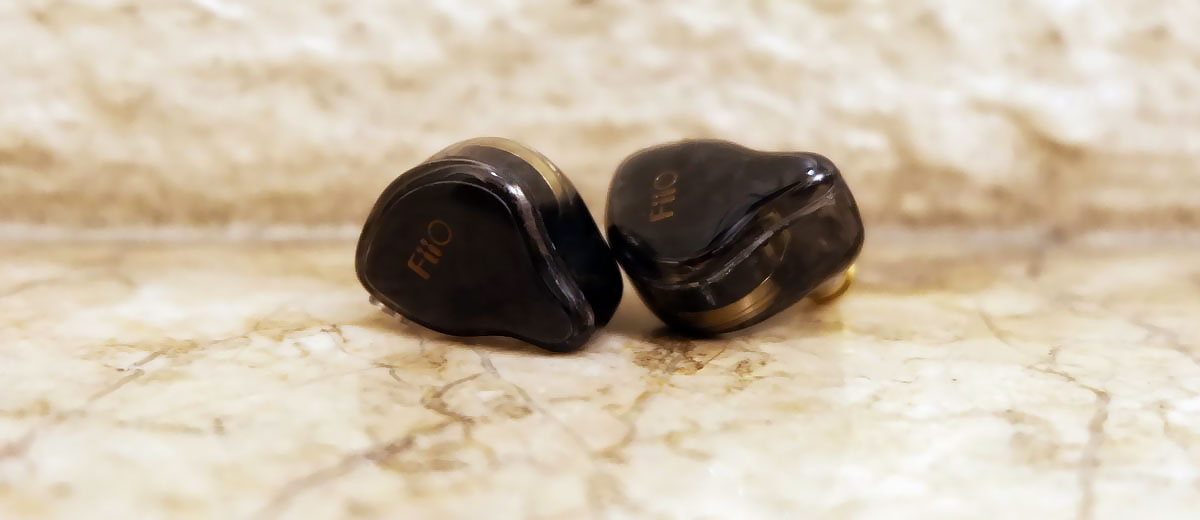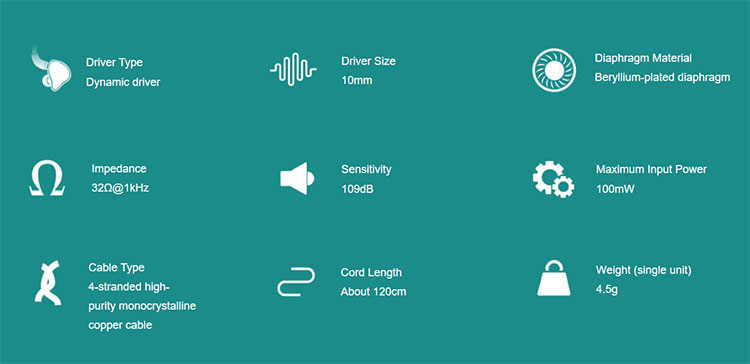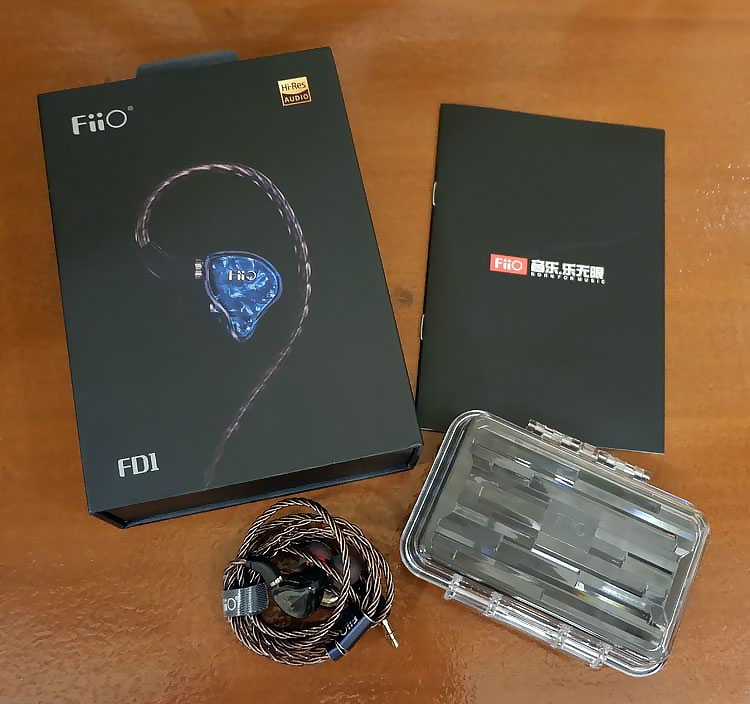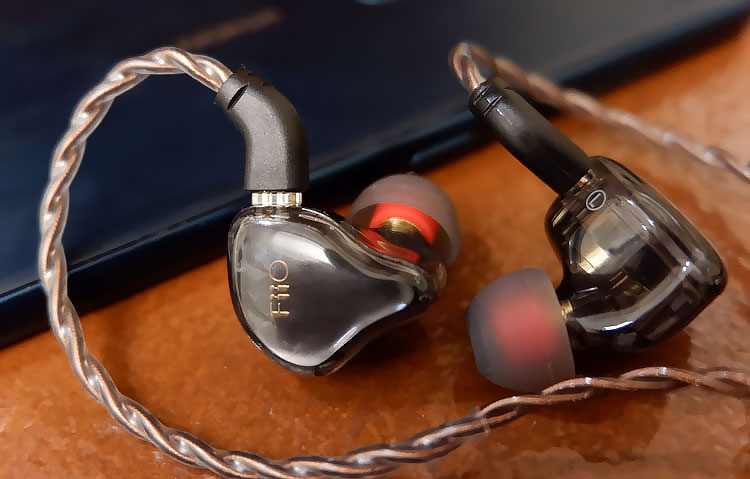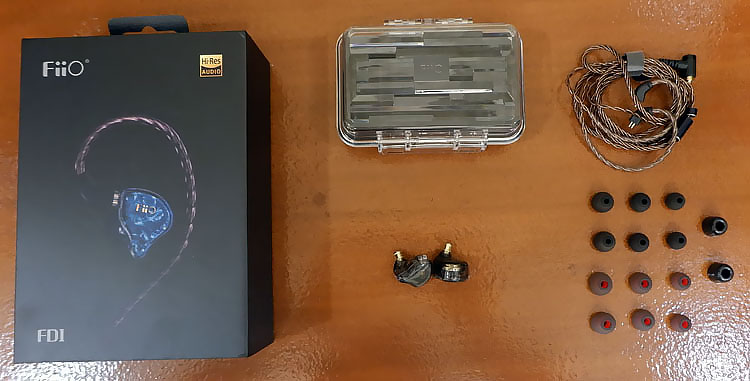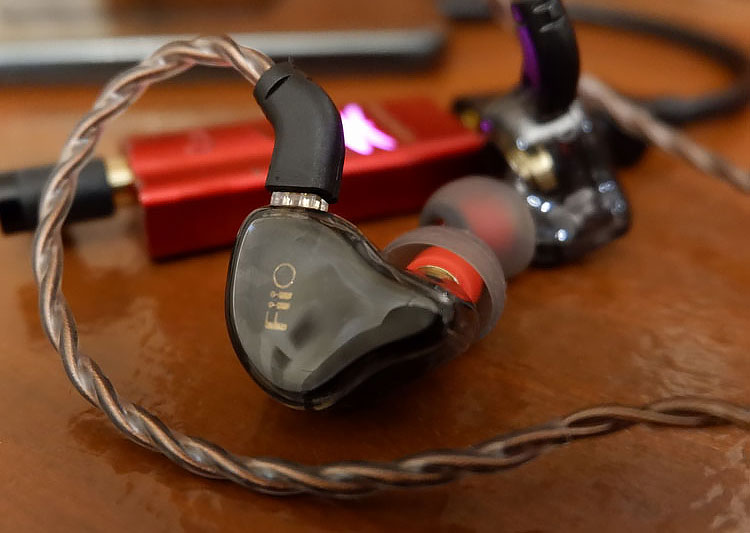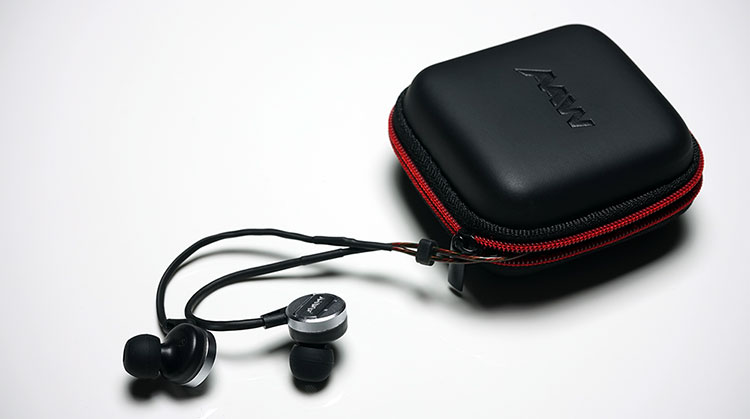The FiiO FD1 is an entry-level single 10mm beryllium-plated dynamic driver universal monitor using N50 2-way magnets and celluloid faceplates. It is currently priced at $59.99.
Disclaimer: The FiiO FD1 sent to us is a sample in exchange for our honest opinion. We thank FiiO for this opportunity.
To learn more about FiiO reviews on Headfonics you can click here.
Note, this review follows our new scoring guidelines for 2020 which you can read up on here.
FiiO has been venturing into the higher-end IEM market with their release of multi-driver IEM’s including their latest flagship the FA9 and the hybrid FH7 to name but a few.
And they have been competing quite well with the big boys in that higher-end sector with some positive feedback. However, it is nice to see that FiiO has not forgotten about creating great products for the budget-conscious audiophile.
The release of the FD1 at $59.99 is classic FiiO and should be worth a demo if aiming for under $100 for a first-time upgrade or even a beater carry about.
Tech Inside
Configuration
The FiiO FD1 comes with a single dynamic driver, and that is it. In a world where there is a race for which the company can produce an IEM with the highest number of drivers crammed into a single shell, FiiO opted for simplicity.
However, the tech inside the FD1 is not to be underestimated, as the two-way magnetic structure is able to produce up to 1 Tesla. This would give the FD1 great power handling capability, as typical neodymium magnet IEM’s only have a magnetic flux density of 0.5 Tesla.
Cone Structure
Furthermore, the cone structure has been coated with beryllium. The beryllium coating would give the dynamic driver cone a more rigid structure. This would enable the driver to create a consistent pistonic motion throughout the whole surface area of the driver cone, despite a continuous repetitive motion to create sound.
This would effectively increase the surface area of the driver producing the sound and decrease the surface area of the driver that would have been creating interference if the driver had not been coated in beryllium.
Trickle Down
Although seemingly simple, the technologies employed by FiiO in the FD1 is nothing but simple. These technologies are the same technologies commonly found in higher-end headphones like Beyerdynamic’s T series with their tesla technology, and Focal with their higher-end headphones that also have Beryllium coated drivers.
Despite not joining the race for the greatest number of drivers crammed into an IEM, the FD1 is still ambitious in that it employed some sophisticated technologies to put together this single dynamic driver IEM.
Package & Accessories
Being positioned as the entry-level in FiiO’s current line up, I didn’t expect much with the FD1’s packaging. I was pleasantly surprised that FiiO did not cheap out on the FD1. The FD1’s came in a nice durable box, that has a magnetic closure flap on the side.
Opening the box shows the IEM’s artfully arranged inside foam inserts on the top part and a box at the bottom that seems to contain the accessories.
I opened the box that contained the accessories and it contained quite a few goodies that I did not expect to come with a pair of $60 IEMs. The first is a clear hard plastic case, the ones we would normally go out of our way to buy to ensure that our IEM’s are protected when in our messy backpacks.
The FD1 came with a few ear tips, a small, medium, and large pair of small-bore ear tips, a small, medium, and large pair of large bore ear tips, and a pair of foam ear tips. They were just separately stored in small plastic bags inside the clear case when I received them though.
I am quite impressed with the accessories that came with the FD1 because this stuff normally would only come with much more expensive IEM’s. Maybe they just got me with the clear hard case, but I know that I’m really satisfied with what the FD1’s come with.
Design
The FD1 came with a specially designed 10mm dynamic driver, housed in clear plastic shells that you can clearly see-through. The faceplate is adorned with a celluloid faceplate and embellished with just the FiiO logo in gold.
Although the shells were primarily made of plastic, the nozzle was still made of metal, making it more robust for when the IEM’s are inserted into the ear canal many times.
Cable
The stock cable that came with the FD1 is made of a monocrystalline copper, 30 cores, 4 strands, without a mic or any controls. The cable was terminated to a 90° 3.5mm single-ended on one end, and a 0.78mm 2 pin connector on the end of the IEM’s themselves.
Both termination ends were nicely done since the 90° termination would be useful for when the FD1’s are plugged into a smartphone inside your jean pocket, and the 0.78mm terminations are ergonomically shaped to follow the curves of the ears making them much easier to put on and stay in place. Nice little details that would make the FD1’s more convenient for daily use.
I would have wanted to have a more secure braid on the main cable, as opposed to the twirls that they used. I am just a bit worried that the twirls might eventually unravel and become unwieldy for storage purposes later on.
Comfort & Isolation
Once I wore the FD1’s I forgot that I was wearing an IEM. I think that is a mark of a well-designed product. The FD1’s have a secure fit since the cable was designed to follow the curve of my ears, so I don’t have to worry about them falling off when I bob my head to the music.
They are also very lightweight, so I do not see them creating issues even when I end up using them for longer listening sessions. With the lightweight materials used, the FD1’s also doesn’t create any cable noise.
As with most IEM’s, the FD1 isolated really well. There was no perceptible outside noise when I put them on, and there was no interference when I start listening to music. The FD1’s really transports me to my own relaxing bubble when I put them on.
Tips
The FD1 came with 3 types of ear tips, which are the small-bore ones with black stems coming in small, medium and large, the large bore ones with red stems coming in small medium and large, and finally a pair of foam ear tips that come in what seems to be medium.
Each type of ear tip gave the FD1’s a distinct coloration and depending on your personal preference you can slightly customize the FD1’s to your taste. It is nice that FiiO gave us that option so that the FD1 would be able to cater to a wider audience.
The small-bore black tips were the most bass shy, but the small-bore tips gave the FD1’s a slightly better sense of space. The foam tips gave the FD1’s quite a bit more bass while cleaning up the sound quite a bit while closing in the sound stage.
Finally, large-bore red silicon tips gave the FD1’s just enough bass presence, while still giving it a bit of breathing room in terms of staging. I decided that I liked the large bore red tips the most, so I just did the rest of the review based on the red tips.
FiiO FD1 Sound Impressions
Summary
With the technologies employed by the FD1, I had some expectations on what it can do, while the price tag said that this should not sound too mind-blowing.
So when I went on to give them a try I was trying to manage my expectations, but I’m glad to say that the sound leaned toward my predictions based on the technologies implemented rather than the one that’s solely based on the price tag.
Bass
Dynamic drivers are typically rolled off towards the extremely low bass frequencies while compensating with a slight mid-bass hump. The nice thing about the bass of dynamic drivers though is the full-bodied quality of the bass frequencies.
I think the bass qualities of the FD1 are easily described by the above qualities, but it exceeds expectations with how controlled and full-bodied the bass frequencies are.
I would like to think that the beryllium coating in the drivers made much of a difference in the bass, because of how well it’s able to keep the driver rigid while being able to give the bass a full-bodied quality with the larger amount of magnetic flux the drivers are able to produce.
Midrange
The FD1 is tuned to have a more neutral frequency response, and the midrange is nicely articulated with the FD1. Although slightly lacking in clarity of the micro details in the midrange, it is far from being grainy. The midrange is a bit forward, but not shouty.
The biggest compliment that I can give the FD1 is that the midrange reminds me a bit of the Sennheiser HD600’s midrange, although lagging behind a bit in clarity, the FD1 has that forwardness and warmth that I’ve come to love with the HD600.
I would say that these are a nice pair of IEMs for traveling if I want to bring along the HD600’s midrange, without actually bringing along the HD600 itself.
Treble
My taste for treble tends to lean towards the more relaxed side to neutral, and I know that I gravitate towards headphones that are a bit treble shy. The FD1 fit that bill quite nicely, however, I am missing some treble sparkle that I have come to love with other higher-end offerings.
Lower priced IEM’s and headphones with a competitive price point, tend to boost the treble frequencies to create the illusion of having a higher amount of clarity.
The FD1 however, is not pretentious about that, the FD1 just shows you what it can naturally do, and I believe this is a good thing. Because overcompensating for shortcomings in resolution by increasing the treble sparkle creates a very bright and fatiguing sound.
The FD1 opted to just be natural about the treble region, not pretending to create an illusion of resolution by making a bright and fatiguing treble region.
Staging
For an IEM of its size, I was surprised that the FD1 performed quite well with a wide sound stage. It might not be way out of my head, but it definitely gave me a sensation of having some sound come from beyond the 2 drivers inside my ears.
However, imaging is quite limited, as the image was limited to far left, far right, and center, with little in between. I think this is one of the few weak points of the FD1, but not at all disappointing given the price point.
Overall FD1 Sound Impressions
With a pair of beryllium coated drivers with the ability to produce a magnetic flux density of 1 Tesla, I’m very happy to say that these sound good.
Despite the limited size of the driver, and having a diameter of just 10mm, the drivers performed much better than the looks and price would suggest.
They sound larger than a pair of IEMs and have a respectable amount of sound stage, a fairly neutral frequency response, only lacking a bit in its imaging and the treble being a splash too light for my taste.
Synergy
I tried the FD1 with my Nokia 7.2 first, and it sounded great, although almost maxing out the volume of my phone, but the clarity and sound stage was present.
I then moved up to testing the FD1 with my Dragonfly Red, but it didn’t make much of a difference except in the ability to make the FD1’s play louder, but the FD1 was already able to sound so good off my phone.
I think it is quite good that the FD1 can sound so good with such meager resources at its disposal. This quality of being able to be driven off a cellphone is quite rare, and desirable in my opinion since this would give you one less thing to worry about.
Not to say that the FD1 would not sound any better if I used better sources, but it simply sounds good enough to have a pleasant experience with something as simple as my phone.
Select Comparisons
Hifiman RE600
Back when the RE600 was initially released in 2013, it was worth around $200, but currently, it sells for just $52 to $72 on their official site. With its current price point, I think that it would be fair to compare it to the FD1.
The RE600 has a more classic design, with a non-detachable woven cable, and the small shells that house what looks like much smaller drivers. They are much lighter and are even less noticeable when worn.
What makes the RE600 special is the ability to present details very clearly, with great imaging, and acceptable sound stage for a pair of IEMs. However, the RE600 sounds brighter and thinner, compared to the FD1’s more neutral and full-bodied presentation.
The sound stage is about the same, while the RE600 just edges out the FD1 in terms of imaging. With the technologies that FiiO has put into the FD1, the FD1 can compete, and sometimes best, an IEM that was once priced at over 3x the FD1’s asking price.
AAW Nebula One
One of my favorite IEM’s that have stayed with me for quite a while was the AAW Nebula one. It’s on the warmer side of neutral, and similar to the FD1 also just has a single driver, housed in a pair of plastic shells.
Sadly, the Nebula One has since been discontinued by the manufacturer, so I’ve been taking good care of the one that I have for quite some time now.
In terms of materials used, they seem to have similar cables, only that the Nebula one doesn’t have detachable cables, but the ear hook design, as well as the weight and feel of the IEMs, are very similar.
The similarities don’t quite stop with the looks of the 2 IEMs though since they sound eerily similar. Only that the Nebula one tends to have a slightly grainier bass region, but they both have a similar sound signature, leaning towards warm while still being able to be fairly neutral.
Sound stage and imaging are also quite similar, managing to be wide, but not too strong when it comes to imaging.
Overall, I’m happy to report that I now have in my hands the spiritual successor to my discontinued Nebula One, although not exactly the same, they’re similar enough for me to be at ease for when the time comes for my Nebula One to finally have to say goodbye.
Our Verdict
With the current trend of most brands going into the race to cram the most drivers into their IEM’s, I think FiiO went with a different approach with the FD1 by employing sensible technologies to make a simple IEM sound it is best.
The combination of a high power 1 Tesla driver, with the rigidity of the beryllium coated driver, made the FD1 a great performer at the entry-level price point.
With how it sounds, I think it stays true to my first impression of FiiO back when I was starting out as an audiophile, is that it would cost quite a bit more to buy something that’s a justifiable upgrade from FiiO’s entry-level offering, the FD1.
FiiO FD1 Specifications
- 10mm Beryllium plated dynamic driver unit
- N50 Two-Way Magnetic Circuit
- 4-Strands High-purity single crystalline copper cable
- Frequency response range: 10Hz-40kHz
- Sensitivity: 109dB/mW
- Impedance: 32Ohms
- 0.78mm 2-pin connectors
- 3.5mm termination plug
- HB1 Carry case

